Crassula tetragona, also known as Miniature Pine Trees, is a unique-looking succulent native to southern Africa. In the wild, its habitat ranges from the Orange River in Namaqualand to the Kei River in the Eastern Cape.
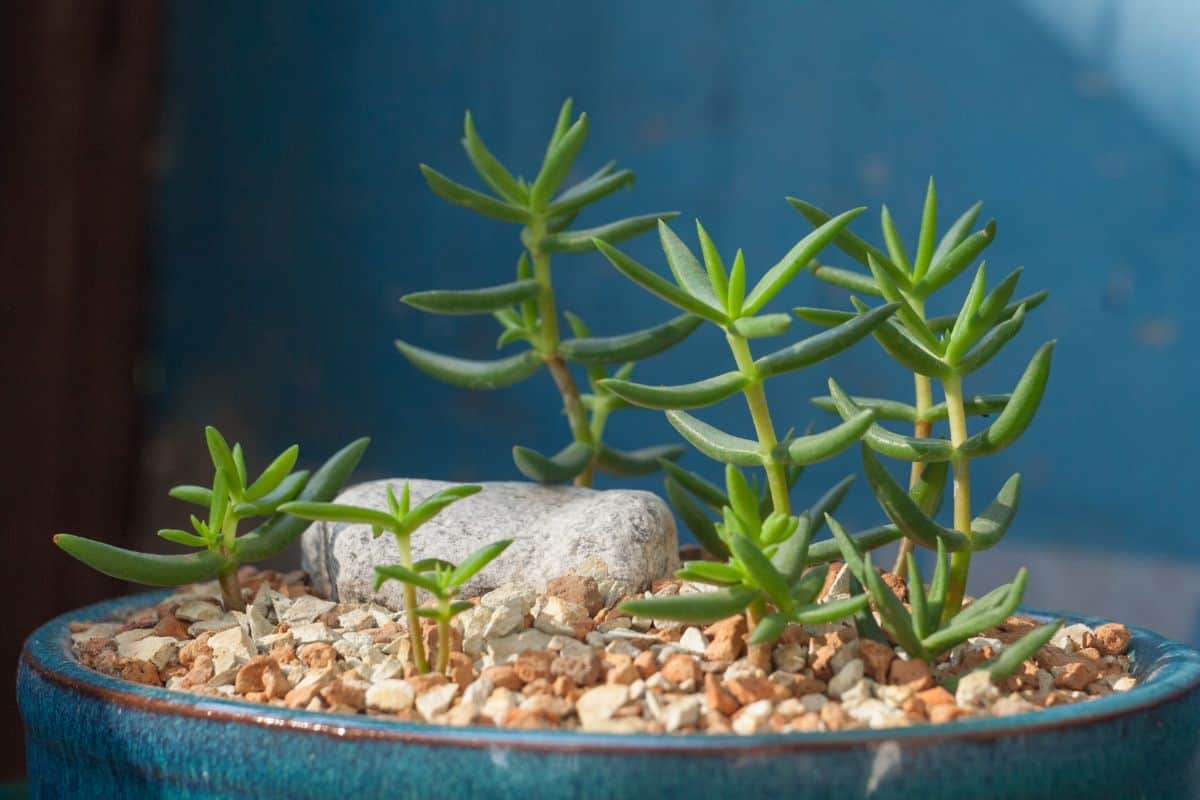
This succulent is prized among collectors for its distinctive foliage and compact size. It’s an especially popular choice for bonsai enthusiasts.
Jump to:
Crassula Tetragona Appearance
| Name: | Crassula tetragona |
| Soil: | Well-draining soil |
| Blooming: | Spring or early summer |
| Light: | Bright light |
| Water: | When the soil is dry out |
| Propagation: | Cuttings, offsets and seeds |
The needle-like leaves and shrubby appearance of Crassula tetragona has led to the nickname Miniature Pine Trees, but make no mistake, this is not a type of pine, it is indeed a succulent.
To add to the pine tree-like appearance, the leaves of C. tetragona are sparsely branched and have a brown, woody bark. The leaves themselves are a vibrant green and are well-spaced in pairs along the stems. The leaves are often described as being shaped like an awl.
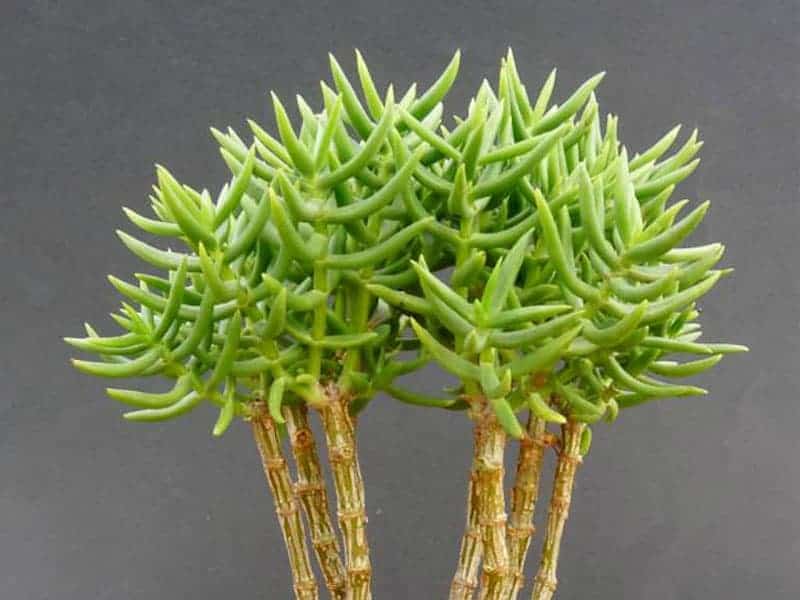
Buy it from:
At maturity, Crassula tetragona can reach just over 3 feet in height. This succulent tends to grow in a shrubby or almost tree-like fashion, though it can be easily trimmed to accommodate any preferences a gardener may have in terms of size and shape.
When in bloom, C. tetragona produces dense clusters of creamy white star-shaped flowers at the tips of the branches. This plant typically blooms in the late spring or early summer.
Subspecies
There are two known subspecies of Crassula tetragona. Though less common than the original variety, the two subspecies also make great additions to any succulent lover’s collection, especially if they enjoy bonsai.
Crassula tetragona subs. Connivens
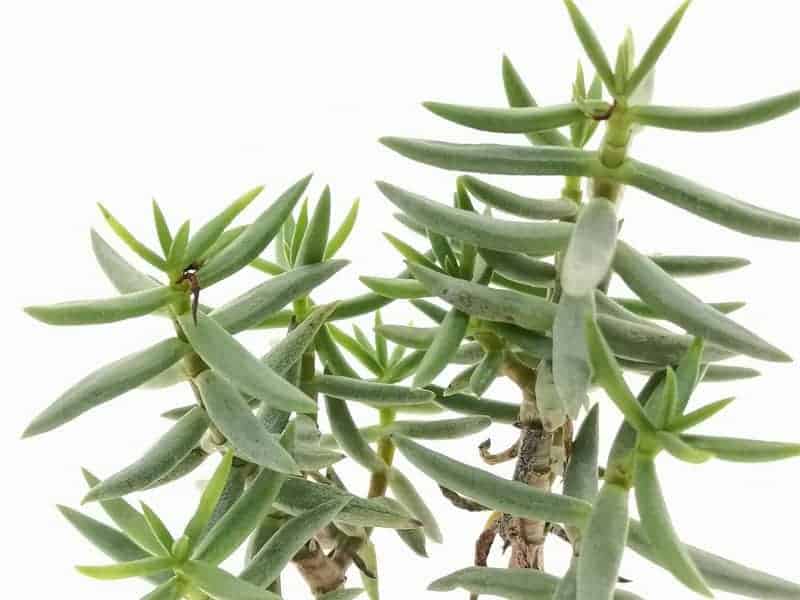
This subspecies naturally only exists in the area of Little and Great Karoo in South Africa. Young plants have papillose stems that become thick and woody as they age. This is the distinguishing characteristic of these subspecies.
Crassula tetragona subs. connivens is generally found on the north side of hills in the shade of other small shrubs and trees. It’s natural altitude ranges from 1200 to 2300 meters above sea level.
Crassula tetragona subs. acutifolia
This subspecies is far less common and can be distinguished by its prostrate growth and roots at the nodes. Its natural habitat ranges from Riversdale to Qonce in South Africa.
Caring for Crassula tetragona
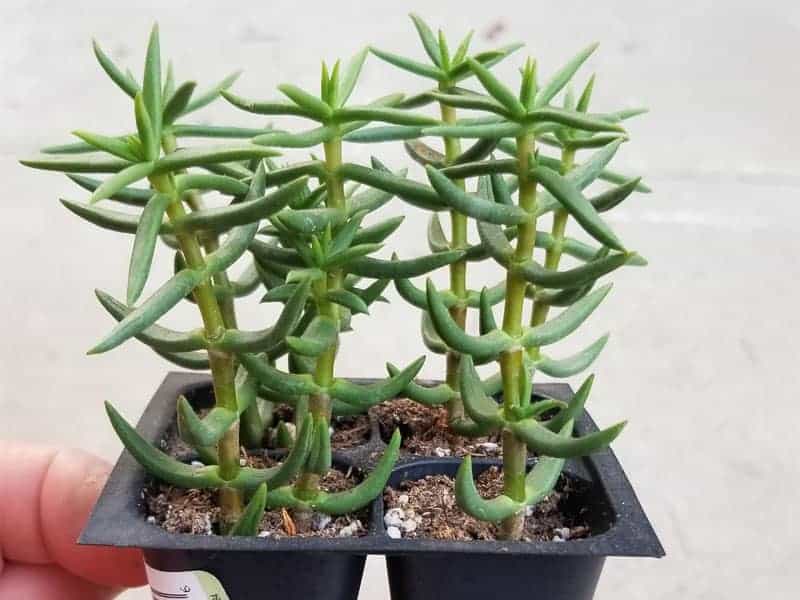
Like other Crassula, C. tetragona is relatively easy to care for. This succulent can easily be kept indoors as a houseplant or grown outside if the climate is appropriate for outdoor succulent growth.
Crassula tetragona is a hardy succulent that is ideal for gardeners with any level of experience. Whether you’re just starting out or have been caring for succulents for years, you should be able to grow this succulent with few problems.
It’s also an ideal succulent for gardeners interested in getting started in bonsai. Bonsai is not a hobby for impatient gardeners, but for those with enough patience, it’s a peaceful and rewarding way to spend your time.
Water
As with most succulents, the most common problem gardeners have with their Crassula tetragona is overwatering. This succulent should be watered deeply but infrequently.
Each time the plant is watered, it should be given enough water so that it drains out of the bottom of the pot. The soil should then be allowed to dry out before watering again.
No products found.
It’s crucial to make sure the soil is dry before watering again to prevent root rot. Root rot is a sneaky disease that isn’t usually obvious until it’s too late to save the plant.
Unless you happen to be repotting and catch it in its early stages, you usually don’t notice until the rot has moved up the plant’s stem. While you may be able to behead the plant and save part of it, most of the time the succulent will not survive at this point.
To ensure that you’re watering a dry succulent, you need to make sure you check the soil before you water. This can be done with a soil moisture meter or just your finger. Insert the soil moisture meter or finger into the soil a few inches deep near the roots.
If the moisture meter reads dry or if the soil feels dry to the touch, it’s safe to water. However, if the soil still contains moisture, you’ll need to wait at least a couple of days before trying again. Remember, it’s always better to err on the side of dryness.
While watering on a set schedule can be helpful in remembering to water your succulents, you’ll need to remember to adjust your watering schedule based on your climate and the weather to prevent your Crassula tetragona from getting too much or too little water.
Cool or humid weather may mean that you need to water your succulents less frequently, while hot and dry weather will mean more frequent water.
Light
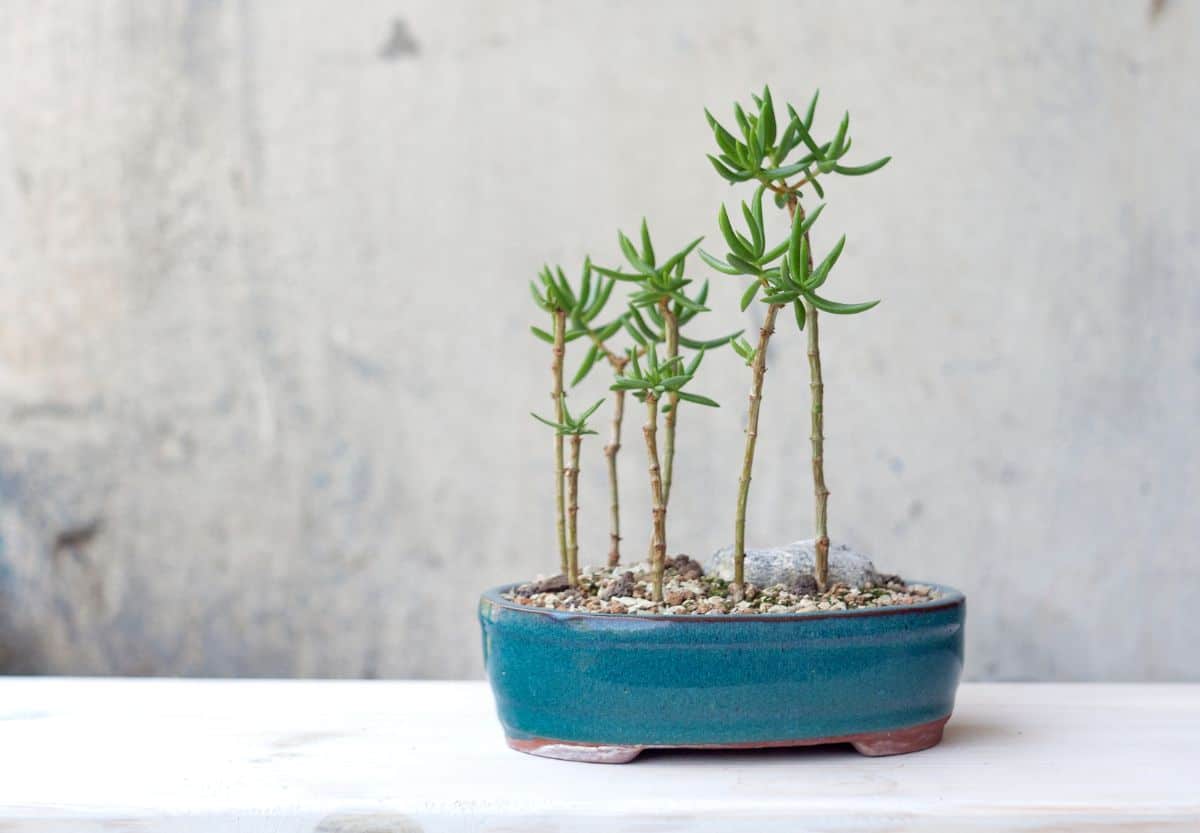
When grown indoors, Crassula tetragona prefers bright light. South, east, or west-facing window should provide the succulent with adequate light.
If adequate light is not available, you may notice your Crassula becoming etiolated, or stretched out. This will become more noticeable over time as the plant stretches toward the light source.
Though etiolation won’t harm your plant, most gardeners find the effect to be unsightly. Unfortunately, once a plant has become etiolated, there’s no way to repair it without propagating the plant and starting over.
In order to make sure your Crassula is getting enough light, you may need to supplement with a grow light. Grow lights are an effective way to prevent etiolation and make sure your plant has enough light no matter where you place it indoors.
Grow lights are available in a range of sizes and shapes to accommodate your indoor garden’s needs. Whether you need a light for a single Crassula tetragona or for an entire shelf of succulents, there’s a grow light to suit your needs.
When grown outdoors, C. tetragona requires filtered or partial sun. Though some direct light is fine, the succulent should be shaded during the hottest hours of the afternoon.
If you plan on growing your Crassula outdoors, you may also want to consider slowly increasing light levels rather than just sticking it outside in the sunlight. A slow transition will help prevent sunburn.
If you notice your plant developing brown or black spots or patches on areas that are exposed to direct light, you’ll know it’s getting too much sun. The darker the color, the more severe the burn.
Like etiolation, sunburn is mainly a cosmetic problem, but if the succulent is exposed to too much direct sunlight for a prolonged period of time, sunburn could be lethal.
By increasing the amount of direct light slowly over a period of several weeks, you can give your Crassula time to adapt which will help prevent it from burning.
If your plant does become sunburned, there’s little you can do to repair the plant. You could trim away the burned areas or just allow your Crassula to grow as normal. Eventually, new growth will replace the burned areas anyway.
Read Related Article: 21 Best Low-Light Indoor Succulents - Dead-Easy to Grow Inside
Temperature
Crassula tetragona is not a frost-hardy plant, so it needs to be protected from freezing temperatures. It may be able to survive a light frost, especially if the soil is dry and the plant is covered, but Crassula cannot survive a hard freeze.
If you see below-freezing temperatures in the forecast, you’ll need to bring the plant indoors so that it can grow near a sunny window or under a grow light until the weather warms up.
C. tetragona is only hardy to USDA Zone 10 or 30-degrees Fahrenheit. If you live in Zone 10 or above, you should be able to grow your succulent outdoors year-round without worry.
Soil
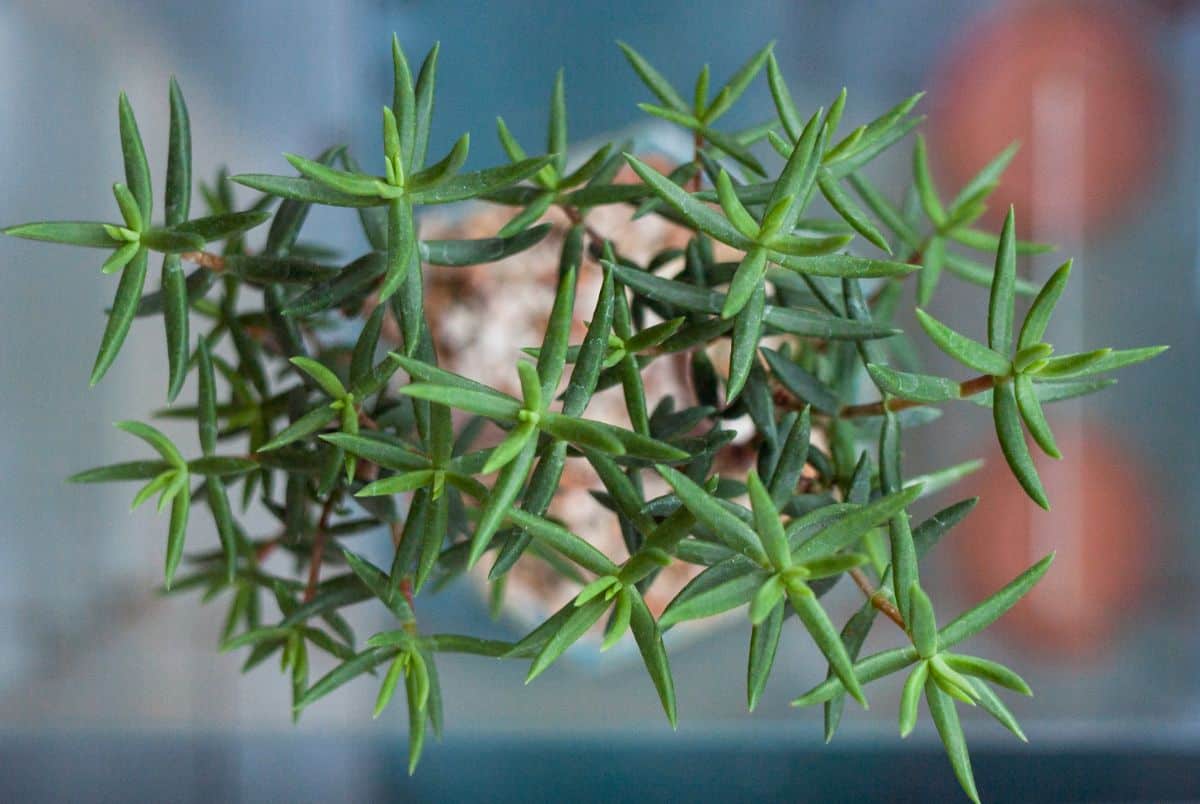
Crassula tetragona has a similar soil requirement as most other succulents. Well-draining soil that dries out quickly is preferred, so avoid any soil that has large quantities of water-retaining ingredients like clay and peat moss.
Instead, look for large particles of gravel, coarse sand, and perlite. Not only do these ingredients promote proper drainage, but they also encourage airflow around the roots, which is essential to good succulent root health.
Commercial cactus soil is an ideal place to start, but you can always alter the soil to suit your plant’s unique needs if necessary, by adding additional sand, gravel, perlite, pumice, or even bark.
Most succulent experts recommend a soil mix of approximately 50% to 70% mineral grit. Just be sure to avoid small particles like fine sand, as they can become compacted more easily and reduce water and airflow.
It’s also worth noting that putting a layer of rocks below the soil in the pot is not an effective way of promoting better drainage. Despite the frequent claims of uninformed gardeners, doing so actually creates a “perched water table” which brings the water closer to the roots of your Crassula, rather than allowing it to drain away.
Container
Once you’ve chosen the right type of soil for your Crassula tetragona, you’ll need to make sure you have the right type of container. There’s no point in choosing well-draining soil if you also choose a container without a drainage hole.
You want your soil and container to allow all excess moisture to drain away from the succulent’s root system to prevent root rot.
While it is technically possible to successfully grow a succulent in a container without a drainage hole, it’s usually discouraged as you have to be incredibly precise about your watering habits.
The material your pot is made of will also have an impact on your watering schedule, so it’s important to choose wisely. Most gardeners recommend terracotta pots as they tend to be the most forgiving.
Terracotta pots absorb some moisture from the soil, which can be great in preventing overwatering, but it also means you’ll need to water more frequently in warm weather as the soil will dry out faster.
Plastic and glazed pots will not absorb any moisture, so if those are your preferred types of pots, you’ll need to plan your watering schedule accordingly.
Fertilizer
Most succulents like Crassula tetragona can survive without fertilizer, but many gardeners find that they can improve their Miniature Pine Trees’ growth with an occasional dose of fertilizer.
If you choose to do so, look for a fertilizer or plant food specifically formulated for use with succulents. You also need to read the label carefully as many brands require the fertilizer to be diluted before applying.
When fertilizing your succulents, be careful not to splash any on the leaves or stems as it could result in a burn. Even if the fertilizer claims to not burn plants, it’s still worthwhile to carefully apply the product to the soil and avoid contact with the plant itself.
Repotting
Crassula tetragona isn’t a fast-growing plant, so you won’t need to repot frequently. Many will grow well in the same container for several years.
However, it’s important to note that even if your succulent hasn’t yet outgrown its container, if it has been there for several years, it may have depleted the soil’s nutrients.
Repot whenever you believe your C. tetragona is ready but be sure to do so during the spring before the plant begins its season of active growth. You’ll also want to make sure that the soil is dry. This will make your job easier and result in less damage to the roots.
Propagating Crassula Tetragona
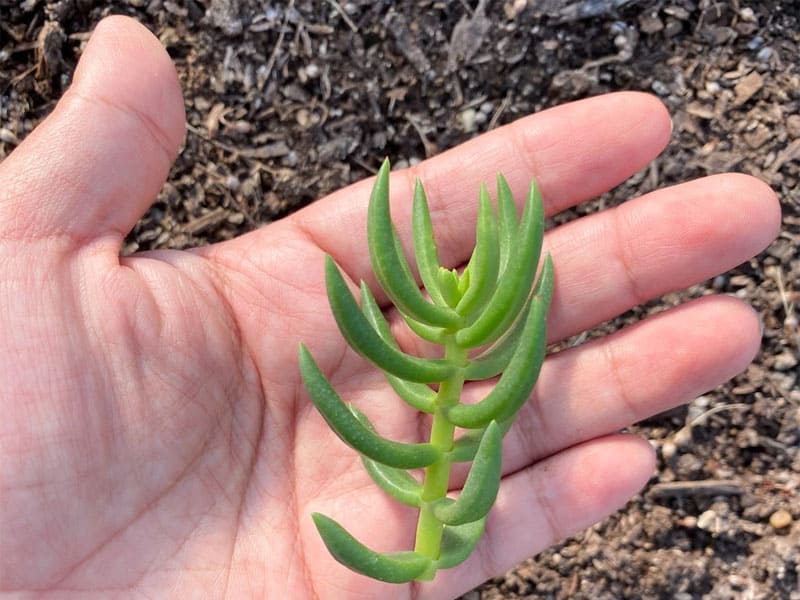
Like other Crassula, C. tetragona is easy to propagate succulent. No matter how much experience you have with succulent propagation, you should have some success with this plant.
There are a few different methods of propagation you can use. No method is better than any other, but many gardeners eventually develop a favorite as they gain experience.
Offsets
The easiest way to propagate Crassula tetragona is by separating the offsets. As the plant grows, it will eventually produce tiny versions of itself around the base of the stem. These offsets, or pups, can be easily removed and repotted in their own containers.
To separate the offsets from the mother plant, use a sharp knife or your fingers to gently divide the plant’s roots. Be sure to handle these tiny plants carefully to avoid damaging them.
Allow the offsets to dry out for a few days to let any wounds callous before planting them in a succulent approved soil mix.
Once you’ve placed the offsets into their own containers, you can immediately begin treating them just as you would a mature Miniature Pine Trees.
Cuttings
Stem cuttings are another easy method of Crassula propagation. Depending on the size of your plant, your stem cuttings can be quite large. You can also take several cuttings to help fill out a pot.
Crassula can also be grown from a single leaf, though leaf propagation typically has a lower rate of success than with stems. Just be sure to choose healthy mature leaves to start with.
To take cuttings from Crassula tetragona, use a sharp pair of scissors or shears to snip a healthy stem or leaf. As with offsets, you’ll need to allow the cuttings to dry out for a few days before placing them in new soil.
This is to prevent any infection that could potentially enter the plant through its wounds once introduced to new soil. This is a rare occurrence, but it’s worth taking the time to improve your cuttings’ chances of survival.
Before placing the Crassula cuttings in soil, you can dip them in rooting hormone powder if you’d like. This isn’t a necessary step, but it can hasten the rooting process. If you’d rather not use rooting hormone, you can introduce the cuttings to well-draining soil after a few days of air drying.
After a few weeks, you should begin to see tiny roots forming at the base of the cutting. At this point, the cutting is ready to be treated more like a mature succulent.
Seeds
Crassula tetragona can also be propagated with seeds, though this is not the quickest method. Growing succulents from seeds is a hobby for the most patient of gardeners, but it can be a fun and rewarding project if you have the time to dedicate to it.
Seeds can be collected from your existing succulent collection, or you can buy them from a reputable seed vendor on the internet. If you have a succulent nursery near you, they may also carry Crassula seeds.
It’s best to sow your succulent seeds in spring or early summer to give them the most growing time. Crassula tetragona seeds usually germinate best at temperatures of around 70 degrees Fahrenheit or lower.
Crassula seeds do not need to be covered, so just sprinkle them over the surface of well-draining soil. You’ll want to keep the soil moist, but not wet, and keep the seeds out of direct sunlight. You may want to cover the seeds to preserve moisture.
After a few weeks, you should begin to see tiny succulent seedlings sprouting from the soil’s surface. Once the seedlings have sprouted, they no longer need to be covered and the soil can be allowed to dry out a bit more.
It’s recommended to allow the seedlings to grow until they have at least three leaves before you transplant them to their own pots. By this time, you can treat them just as you would a mature plant.
Remember, you’re starting a plant from scratch, so don’t expect to have a mature C. tetragona any time soon. Succulents tend to be slow-growing plants, so it’s important to be patient when propagating from seeds.
You May Also Like: Dinteranthus
Common Pests and Problems
With proper care, Crassula tetragona is not a plant that’s prone to many problems or diseases. However, they can fall victim to pest infestations, especially if proper plant hygiene guidelines aren’t followed.
Most pests need warmth, moisture, and food, so it’s important to water only when needed and cleans up any dead plant material. Rotting leaves or stems and excessive moisture are a recipe for a pest disaster, so be sure to keep your pots clean and allow the soil to dry out before watering.
You should also be sure to quarantine any new plants for a few weeks before placing them with your existing succulent collection. This may seem extreme, but it’s easier to treat just a few new plants for pests than your entire garden.
The most common pests to look out for with Crassula tetragona are mealybugs, spider mites, and aphids. Fortunately, most of these pests are relatively easy to treat, though it can take time, especially with a large infestation.
Most pests have a rapid lifecycle, which means their population can explode in just a matter of weeks. At any given time, you’ll likely be treating the pests in a variety of life stages, so it can take several weeks or even months to fully eliminate them once they’ve taken hold of your plants.
In order to prevent a pest population boom, it’s important to check on your plants at least weekly, if not more frequently. Even if you don’t want them that often, it’s worth checking them out to make sure you don’t have any problems developing.
As you check out your plants, be sure to check the undersides of the leaves, as this is the most commonplace for insects to inhabit.
It’s also not uncommon for Crassula to develop diseases such as bacterial soft rot, black ring disease, and powdery mildew, so be sure to look for signs of these problems as well.


